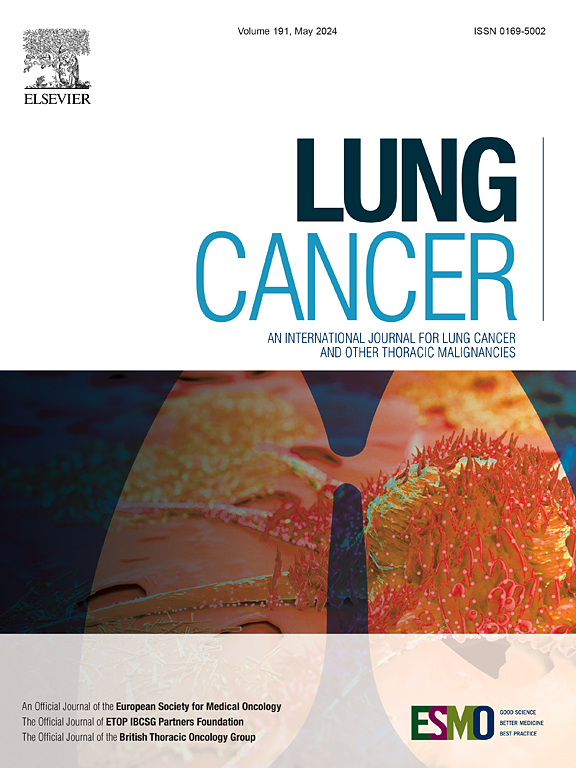评估新型免注册 CT 引导穿刺活检导航系统 (RC 120) 的有效性和安全性:多中心前瞻性临床试验。
IF 4.5
2区 医学
Q1 ONCOLOGY
引用次数: 0
摘要
背景:目前的经皮穿刺活检(PTNB)导航系统由于额外的步骤和手术环境的限制而面临挑战:我们开发了一种新型免注册导航系统,可在 CT 引导下快速精确地进行经皮穿刺活检,无需体表标记和术中注册。本研究对其有效性和安全性进行了评估:一项前瞻性研究于 2021 年 12 月至 2022 年 8 月在两个临床中心对 18-80 岁准备进行 PTNB 的参与者进行了研究。主要终点是活检针调整两次内的成功率,次要终点是单次调整内的成功率。安全性终点由不良事件的发生情况来定义:研究共纳入 98 名患者(中位年龄 64 岁,IQR 54-69 岁,71 名男性)。主要终点的活检成功率为 98.98%,次要终点为 97.96%。总体成功率为 98.98%,大大超过了 85% 的目标值(P < 0.0001)。CT 扫描的中位数为 3 次,明显少于手动穿刺方案的预测值 [3 (IQR 3-3) to 8 (IQR 6-8), P < 0.0001]。平均手术时间为 18.0 分钟(IQR:14.0-29.0 分钟)。最常见的不良事件是出血(14 例)和气胸(8 例)。其他不良事件包括血压升高、咯血和其他常见事件:我们的免注册导航系统被证明是临床实践中辅助经皮肺活检的有效而安全的系统。本文章由计算机程序翻译,如有差异,请以英文原文为准。
Evaluating efficacy and safety of a novel registration-free CT-guided needle biopsy navigation system (RC 120): A multicenter, prospective clinical trial
Background
Current percutaneous transthoracic needle biopsies (PTNB) navigation systems present challenges due to additional steps and limitations on the operating environment.
Research Question
We developed a novel, registration-free navigation system for swift and precise CT-guided PTNB, eliminating the need for body surface markers and intraoperative registration. This study assesses its efficacy and safety.
Methods
A prospective study was conducted on participants aged 18–80 years prepared for PTNB at two clinical centers, from December 2021 to August 2022. The primary endpoint was the success rate of biopsies within 2 needle adjustments, and the secondary endpoint was the success rate within a single adjustment. Safety endpoints were defined by adverse events occurrence.
Results
The study included 98 patients (median age, 64 years, IQR 54–69 years, 71 men). The primary endpoint achieved a biopsy success rate of 98.98 %, and the secondary endpoint demonstrated 97.96 %. The overall success rate was 98.98 %, significantly exceeding the target value of 85 % (P < 0.0001). The median number of CT scans was 3, significantly fewer than predicted for the manual puncture scheme [3 (IQR 3–3) to 8 (IQR 6–8), P < 0.0001]. The average procedure duration was 18.0 min (IQR: 14.0–29.0 min). The most common adverse events were hemorrhage (14 instances) and pneumothorax (8 instances). Other adverse events included elevated blood pressure, hemoptysis, and other common events.
Interpretation
Our registration-free navigation system proved to be an effective and safe system for assisting percutaneous lung biopsies in clinical practice.
求助全文
通过发布文献求助,成功后即可免费获取论文全文。
去求助
来源期刊

Lung Cancer
医学-呼吸系统
CiteScore
9.40
自引率
3.80%
发文量
407
审稿时长
25 days
期刊介绍:
Lung Cancer is an international publication covering the clinical, translational and basic science of malignancies of the lung and chest region.Original research articles, early reports, review articles, editorials and correspondence covering the prevention, epidemiology and etiology, basic biology, pathology, clinical assessment, surgery, chemotherapy, radiotherapy, combined treatment modalities, other treatment modalities and outcomes of lung cancer are welcome.
 求助内容:
求助内容: 应助结果提醒方式:
应助结果提醒方式:


